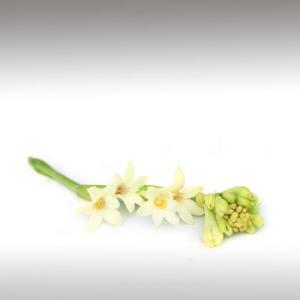
TUBEROSE ESSENTIAL OIL (POLIANTHES TUBEROSA) - ESSENTIAL OILS

BASE / GENERAL DATA
Information submited: April 17, 2015 Modified: March 23, 2018 By: OperaDreamhouse
Botanical Name: Polianthes tuberosa
Common Method of Extraction: Solvent extraction
Part Typically Used: Flowers
Color:
Consistency:
Perfumery Note: Top
Strength of Initial Aroma: White floral, camphor, dewy mushroom and earth, buttery, rubbery and even metallic facets.
Tuberose is not a very popular name in the world of herbal medicines. In fact, it is very popular and priced among perfume manufacturers.
Due to this, Tuberose is popularly known as “Night Queen”, “Mistress of the Night”, or “Raat ki Raani”, as it known in Hindi. It grows well in Central America and India and is in high demand in the countries of the Indian Subcontinent, Middle East, and Africa in order to make perfume.
Members of the closely related genus Manfreda are often called "Tuberoses". In the Philippines, the plant is also known as Azucena, and, while once associated with funerals, it is now used in floral arrangements for other occasions.
The Tuberose is a night-blooming plant native to Mexico, as is every other known species of Polianthes. It grows in elongated spikes up to 45 cm long that produce clusters of fragrant waxy white flowers that bloom from the bottom towards the top of the spike. It has long, bright green leaves clustered at the base of the plant and smaller, clasping leaves along the stem.
Now It is cultivated all over the world for the cut flower trade, but specially in Egypt, China, France and Morocco for its oil.
The Tuberose (Polianthes Tuberosa) is a perennial plant related to the agaves, extracts of which are used as a note in perfumery. The common name derives from the Latin Tuberosa, meaning swollen or Tuberous in reference to its root system. Polianthes means "Many flowers" in Greek. In Mexican Spanish, the flower is called Nardo or Vara de San José, which means "St. Joseph’s staff".
The Victorians must have been among the latter: they forbade young girls of inhaling the scent of Tuberose in the fear they might have a spontaneous orgasm. Roja Dove is right when he says that Tuberose is really loose, the "Harlot of perfumery".
The natural blossoms are so powerful they can fill a room and continue to exude their scent for days after picking.
Tuberose essential oil behaves as an aphrodisiac and its very strong, intense and intoxicating floral fragrance fills the air and creates an atmosphere of love.
Tuberose essential oil is world famous for its use in perfumes and the rich, intense and long lasting floral fragrance is an ideal choice for a deodorant and that is why it is so popular in the countries with hot and humid climate, as they have to deal with sweat and resultant body odor.
Tuberose enfleurage oil cannot be distilled like most essential oils due to the delicate nature of the flowers. Enfleurage was the traditional method of extraction used in ancient Egypt and into the early 20th century but solvent extraction using hexane, to create “Absolutes”, has virtually replaced enfleurage.
In South America who extracts the essential oil from the flower by the ancient method of enfleurage, using only Palm oil (organic) and Alcohol (organic) derived from local Sugar Cane (organic).
The entire process of extracting the Tuberose oil it done by hand using no heat and no harsh chemical solvents. Pure local Palm oil is used to absorb the aromatic oils from the Tuberose flower petals and once the Palm oil is completely saturated with the essence of the Tuberose flower then the Palm oil is separated from the Tuberose oil by Cane Sugar Alcohol which is then evaporated to leave only the pure Tuberose oil.
Over 3500 pounds of blossoms are needed to produce 1 pound of the essential oil which is why Tuberose enfleurage essential oil is one of the most expensive oils on earth, even more than most Rose Attars.
Chemical structure:
The main chemical components are menthyl benzoate, menthyl anthranilate, benzyl alcohol, butyric acid, eugenol, nerol, farnesol and geraniol.
Common Method of Extraction: Solvent extraction
Part Typically Used: Flowers
Color:
Consistency:
Perfumery Note: Top
Strength of Initial Aroma: White floral, camphor, dewy mushroom and earth, buttery, rubbery and even metallic facets.
Tuberose is not a very popular name in the world of herbal medicines. In fact, it is very popular and priced among perfume manufacturers.
Due to this, Tuberose is popularly known as “Night Queen”, “Mistress of the Night”, or “Raat ki Raani”, as it known in Hindi. It grows well in Central America and India and is in high demand in the countries of the Indian Subcontinent, Middle East, and Africa in order to make perfume.
Members of the closely related genus Manfreda are often called "Tuberoses". In the Philippines, the plant is also known as Azucena, and, while once associated with funerals, it is now used in floral arrangements for other occasions.
The Tuberose is a night-blooming plant native to Mexico, as is every other known species of Polianthes. It grows in elongated spikes up to 45 cm long that produce clusters of fragrant waxy white flowers that bloom from the bottom towards the top of the spike. It has long, bright green leaves clustered at the base of the plant and smaller, clasping leaves along the stem.
Now It is cultivated all over the world for the cut flower trade, but specially in Egypt, China, France and Morocco for its oil.
The Tuberose (Polianthes Tuberosa) is a perennial plant related to the agaves, extracts of which are used as a note in perfumery. The common name derives from the Latin Tuberosa, meaning swollen or Tuberous in reference to its root system. Polianthes means "Many flowers" in Greek. In Mexican Spanish, the flower is called Nardo or Vara de San José, which means "St. Joseph’s staff".
The Victorians must have been among the latter: they forbade young girls of inhaling the scent of Tuberose in the fear they might have a spontaneous orgasm. Roja Dove is right when he says that Tuberose is really loose, the "Harlot of perfumery".
The natural blossoms are so powerful they can fill a room and continue to exude their scent for days after picking.
Tuberose essential oil behaves as an aphrodisiac and its very strong, intense and intoxicating floral fragrance fills the air and creates an atmosphere of love.
Tuberose essential oil is world famous for its use in perfumes and the rich, intense and long lasting floral fragrance is an ideal choice for a deodorant and that is why it is so popular in the countries with hot and humid climate, as they have to deal with sweat and resultant body odor.
Tuberose enfleurage oil cannot be distilled like most essential oils due to the delicate nature of the flowers. Enfleurage was the traditional method of extraction used in ancient Egypt and into the early 20th century but solvent extraction using hexane, to create “Absolutes”, has virtually replaced enfleurage.
In South America who extracts the essential oil from the flower by the ancient method of enfleurage, using only Palm oil (organic) and Alcohol (organic) derived from local Sugar Cane (organic).
The entire process of extracting the Tuberose oil it done by hand using no heat and no harsh chemical solvents. Pure local Palm oil is used to absorb the aromatic oils from the Tuberose flower petals and once the Palm oil is completely saturated with the essence of the Tuberose flower then the Palm oil is separated from the Tuberose oil by Cane Sugar Alcohol which is then evaporated to leave only the pure Tuberose oil.
Over 3500 pounds of blossoms are needed to produce 1 pound of the essential oil which is why Tuberose enfleurage essential oil is one of the most expensive oils on earth, even more than most Rose Attars.
Chemical structure:
The main chemical components are menthyl benzoate, menthyl anthranilate, benzyl alcohol, butyric acid, eugenol, nerol, farnesol and geraniol.

SPIRITUAL PRACTISES DATA

MEDICINE / HEALTH DATA

BEAUTY / COSMETICS DATA

FOOD / COOKING DATA
COMMENTS
No comments.


